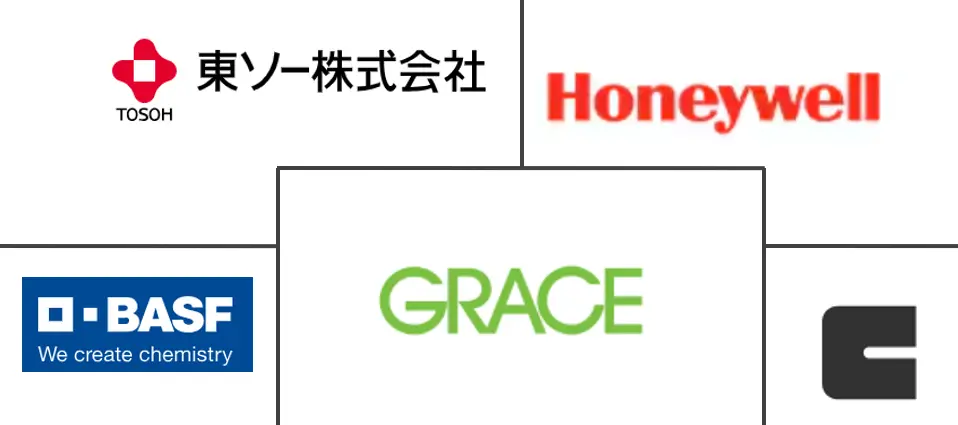Zeolites Market Size and Share
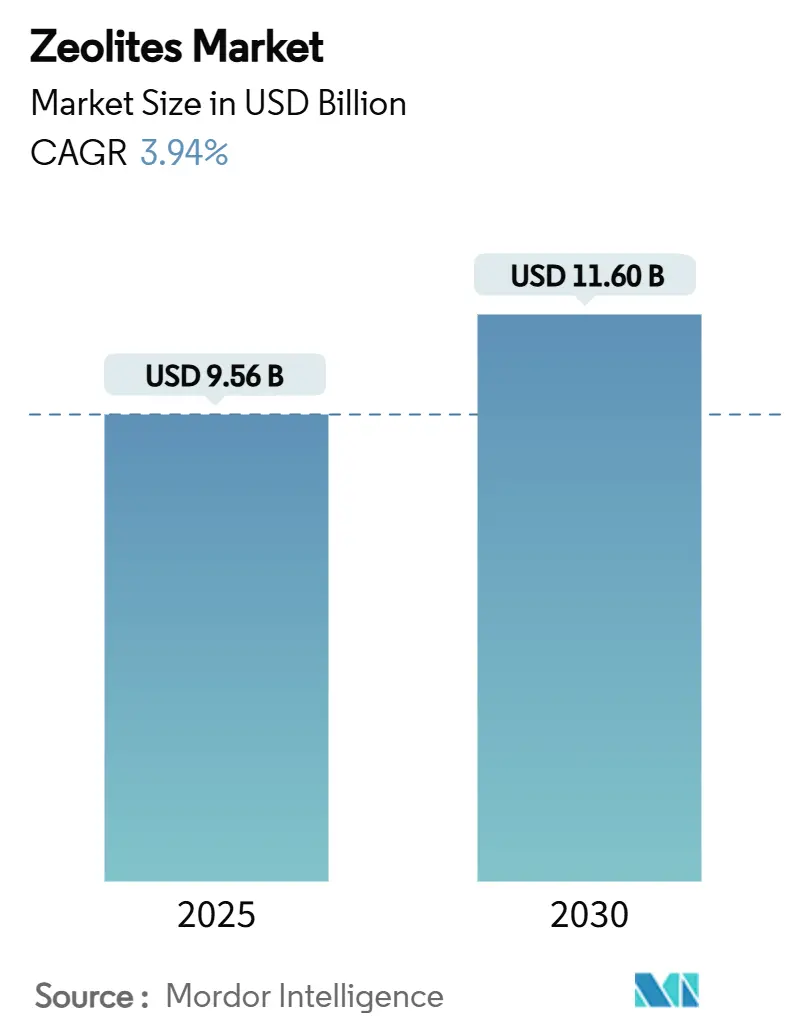
Zeolites Market Analysis by Mordor Intelligence
The Zeolites Market size is estimated at USD 9.56 billion in 2025, and is expected to reach USD 11.60 billion by 2030, at a CAGR of 3.94% during the forecast period (2025-2030). Robust demand from water treatment, petrochemical catalysis, and next-generation membrane technologies underpins steady growth. Asia-Pacific leads the global zeolite market as tightening environmental rules spur catalyst and adsorbent uptake. Water treatment is the most dynamic end-use, on the back of stricter heavy-metal discharge limits, while petrochemical applications retain the largest slice due to their entrenched role in fluid catalytic cracking.
Key Report Takeaways
- By product type, natural grades held 55% of the zeolite market share in 2024, while synthetic variants are projected to log the fastest 5.60% CAGR through 2030.
- By form, powder accounted for 60% of the zeolite market size in 2024; membranes and coatings are poised to expand at a 6.11% CAGR to 2030.
- By application, catalysts generated 35% of 2024 revenue, yet adsorbents will record the quickest 5.50% CAGR during 2025-2030.
- By end-user industry, petrochemicals led with 40% of the zeolite market share in 2024; water treatment is forecast to rise at a 6.50% CAGR to 2030.
- By geography, Asia-Pacific contributed 45% of global sales in 2024, growing 6.20% to 2030.
Global Zeolites Market Trends and Insights
Driver Impact Analysis
| Driver | (~) % Impact on CAGR Forecast | Geographic Relevance | Impact Timeline |
|---|---|---|---|
| Water treatment demand surge | +2.5% | Global, led by Asia-Pacific and Europe | Long term (≥ 4 years) |
| Adsorption refrigeration uptake | +2.2% | Emerging economies in Asia and Africa | Medium term (2-4 years) |
| Petrochemical capacity additions in China and GCC | +1.5% | Asia-Pacific and Middle East | Long term (≥ 4 years) |
| Growth in environmental catalysis | +1.2% | Europe and North America | Medium term (2-4 years) |
| Growth in environmental catalysis | +1.2% | Europe and North America | Medium term (2-4 years) |
| Source: Mordor Intelligence | |||
Increasing Demand from Water Treatment Industry
Heightened concern over heavy-metal and emerging contaminant discharge drives utilities to adopt high-capacity zeolite adsorbents. Graphene-oxide-modified zeolites now remove up to 119 mg g⁻¹ of methylene blue at 333 K, outstripping conventional media. Acid-treated clinoptilolite achieves 94% Pb²⁺, 86% Cd²⁺ , and 84% As³⁺ removal, positioning natural zeolites as cost-effective substitutes for activated carbon in municipal systems. In parallel, utilities in Europe and Asia are piloting zeolite-packed columns to meet upcoming chromium and manganese limits, underpinning multi-year growth for the zeolite market.
Increasing Use of Zeolite as Refrigeration Adsorbents
Adsorption chillers based on zeolite–water pairs cut electricity use and eliminate high-GWP refrigerants. Zeolites’ microporous framework adsorbs water vapor at low partial pressure, enabling cooling with waste heat streams around 60 °C. Innovations such as 40% better heat-transfer coatings shorten cycle time and lift system COP, bringing commercial adoption closer in off-grid cold-chain and data-center cooling[1].Rajesh Kumar and Anjali Sharma, “Zeolite Properties, Methods of Synthesis, and Selected Applications,” Molecules, pmc.nih.gov These advances bolster medium-term demand and expand the zeolite market into energy-efficiency niches.
Growth of Petrochemical Capacity Additions in China and Middle East Elevating Demand for FCC Catalysts Based on Y-Zeolite
China’s refineries and crackers are upgrading to propylene-maximization modes that depend on metals-tolerant Y-zeolite catalysts. At the same time, GCC producers diversify into higher olefins, requiring specialty zeolite formulations that resist coke buildup from heavy crudes. Catalyst suppliers respond with hierarchically structured zeolites exhibiting enhanced diffusivity, supporting long-term volume gains for the zeolite market.
Growing Demand in Catalysis
Copper-exchanged chabazite zeolites achieve more than 90% NOx abatement between 200 °C and 450 °C, and AI-driven modeling is refining active-site design, accelerating automotive homologation. Parallel work at Oak Ridge National Laboratory shows more than 80% CH₄/CO₂ conversion to syngas over Ni-zeolite catalysts, opening carbon-to-chemicals pathways. Environmental catalysis, therefore, represents a fast-rising, regulation-driven stream within the zeolite market.
Restraint Impact Analysis
| Restraint | (~) % Impact on CAGR Forecast | Geographic Relevance | Impact Timeline |
|---|---|---|---|
| Low-cost silica gel and activated carbon competition | −0.9% | Price-sensitive regions worldwide | Short term (≤ 2 years) |
| Aluminosilicate feedstock volatility | −1.5% | China, Indonesia, global markets | Medium term (2-4 years) |
| EU catalyst-disposal regulations raising spent-zeolite costs | −1.0% | Europe | Short term (≤ 2 years) |
| Source: Mordor Intelligence | |||
Abundant Availability of Low-Cost Silica Gel and Activated Carbon Adsorbents Reducing Zeolite Uptake in Industrial Drying
Silica gel undercuts zeolite pricing by 30-40%, steering commodity drying customers toward cheaper media. Performance advantages of zeolites, higher capacity under humid atmospheres and regenerability above 200 °C, often remain undervalued, delaying conversions in bulk chemicals and grain storage. Producers counter by launching hybrid blends that lower upfront cost while showcasing lifecycle savings, yet market education remains a near-term hurdle.
Volatility in Aluminosilicate Feedstock Costs Due to Bauxite Mining Restrictions
Environmental curbs on bauxite extraction in China and Indonesia have tightened alumina supply, raising synthetic zeolite input costs and squeezing margins. High-alumina frameworks, essential for specialty catalysis, face the sharpest hikes. Research into kaolin-waste-based green synthesis promises to reduce reliance on virgin bauxite and cut production costs by up to 20%, potentially easing medium-term pressure on zeolite market growth.
Segment Analysis
By Product Type: Natural Grades Maintain Lead While Engineered Variants Accelerate
Natural zeolites commanded 55% of the market in 2024 thanks to vast deposits of clinoptilolite, chabazite, and mordenite that require only crushing and sizing before use. These minerals support agriculture, livestock, and bulk adsorption, giving them a durable cost edge over synthetics. Acid-modified clinoptilolite now removes 94% Pb²⁺ and 84% As³⁺, narrowing the performance gap with engineered frameworks.
Synthetic zeolites will post a 5.60% CAGR. Precision control of Si/Al ratio and pore topology enables high activity in FCC, hydrocracking, and NOx reduction. The zeolite market size for synthetic Y-type catalysts alone is projected to expand with rising heavy-oil processing. Suppliers devote significant research and development to dual-framework designs that unlock higher light-olefin yields, sustaining premium pricing and margin resilience.
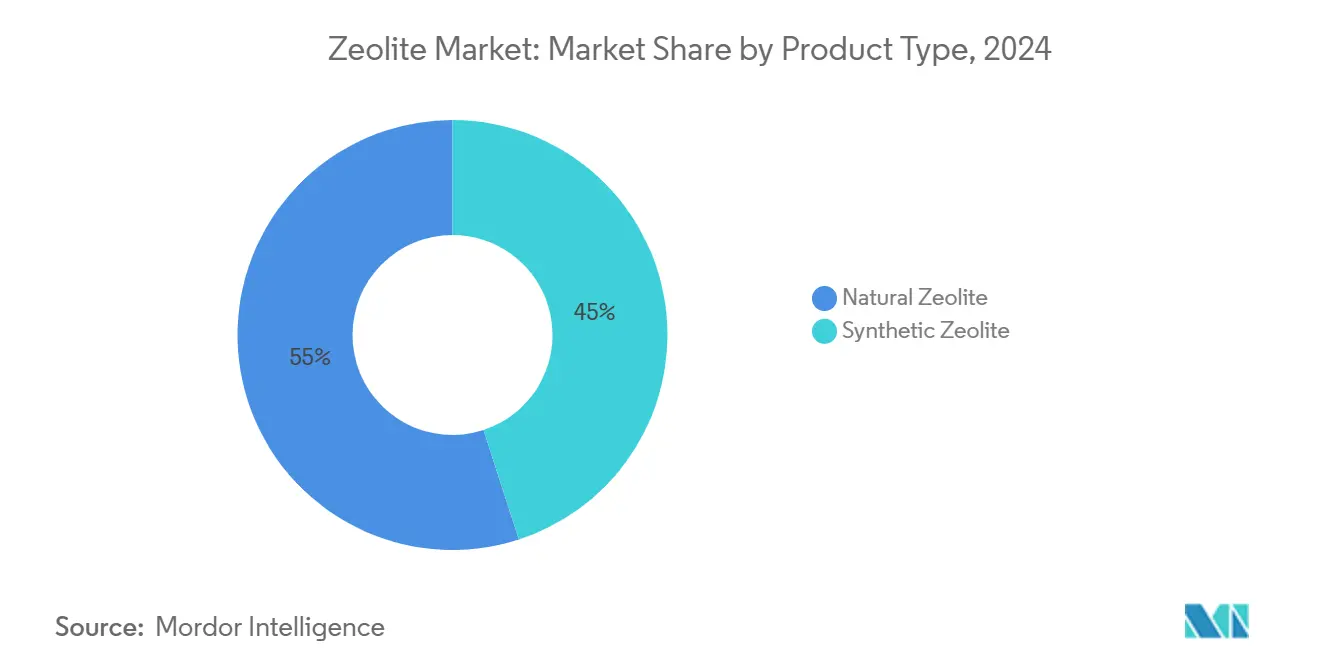
Note: Segment shares of all individual segments available upon report purchase
By Form: Powders Dominate While Membrane Coatings Surge
Powders retained 60% revenue in 2024, underpinning detergent, catalyst slurry, and master-batch applications. Their high external surface area guarantees rapid adsorption and easy dispersion. Stable demand from laundry builders and FCC catalysts anchors this segment of the zeolite market.
Membrane/coating formats, while still niche, will rise 6.11% annually. Seamless, defect-free zeolite layers on ceramic or metal substrates now deliver molecular sieving for hydrogen purification and ethanol dehydration. Breakthroughs in secondary growth techniques produce sub-100 nm oriented ZSM-5 films, slashing permeance loss. Several European pilot installations target post-combustion CO₂ capture, hinting at sizeable upside for this advanced form factor within the broader zeolite market.
By Application: Catalysts Lead, Adsorbents Advance Fastest
Catalysts generated 35% of 2024 revenue, anchored by FCC units that treat 15 million barrels per day. W.R. Grace’s NEKTOR 4G, featuring dual-zeolite matrices, exemplifies continuous innovation aimed at heavier feeds. Zeolite frameworks’ shape-selectivity ensures they remain irreplaceable for propylene-maximization and BTX production, safeguarding their dominant share of the zeolite market.
Adsorbents, however, will outpace all other uses at 5.50% CAGR. Synthetic NaP1_FA and zeolite-carbon composites remove more than 90% of pharmaceuticals within a 2-minute contact time, a critical advantage for tertiary wastewater polishing. Growing legislative focus on trace organics will funnel investment toward high-capacity zeolite adsorbents, enlarging the zeolite market size for this application band.
By End-User Industry: Petrochemicals Remain Core, Water Treatment Surges
Petrochemical plants accounted for 40% revenue in 2024, a testament to zeolites’ central role in cracking, isomerization, and alkylation circuits. Research into hierarchically structured Y-zeolites extends cycle length and mitigates vanadium poisoning, reinforcing the segment’s scale.
Though representing a smaller base, water utilities will expand 6.50% per year. Modified zeolite filters now capture 98% Fe³⁺ and 95% Mn²⁺ from well water, enabling compliance with World Health Organization limits at modest operating cost. Heightened investment in decentralized treatment across Asia-Pacific propels this use case, further diversifying the zeolite market.

Note: Segment shares of all individual segments available upon report purchase
Geography Analysis
Asia-Pacific held 45% of global sales in 2024, reflecting unrivaled petrochemical expansion, rapid urbanization, and stringent regional emission directives. China’s 14th Five-Year Plan backs local catalyst innovation, ensuring secure supply for propylene-rich crackers and driving steady demand across the zeolite market. Parallel policies mandating low-NOx combustion and advanced wastewater plants catalyze broader uptake.
Europe prioritizes environmental performance, pushing automakers to adopt Cu-CHA catalysts and refiners to install desulfurization adsorbers that rely on zeolite frameworks. The European Green Deal’s circular-economy measures, including mandatory waste-oil re-refining targets of up to 85% by 2030, elevate future adsorbent requirements[2]Marschinski, “The Economics of Waste Oil Recycling in the EU,” Journal of Environmental Economics and Policy, tandfonline.com .
North America maintains robust consumption through its established refinery network and rising adoption of zeolite-based SCR and GHG-to-chemicals catalysts. Domestic sourcing initiatives encourage capacity additions for high-silica frameworks, reinforcing supply security for specialty applications and supporting the zeolite market’s steady North American footprint.
The Middle-East leverages abundant crude to build integrated complexes targeting higher-value olefins and aromatics. GCC investments in residue-upgrading hinge on zeolite catalysts able to tolerate sulfur and metals, ensuring consistent order flow. Africa and South America remain emerging but promising; Brazilian projects tackling groundwater contamination via clinoptilolite beds exemplify localized water treatment growth. Collectively, these regions add incremental volume that reinforces global zeolite market expansion.
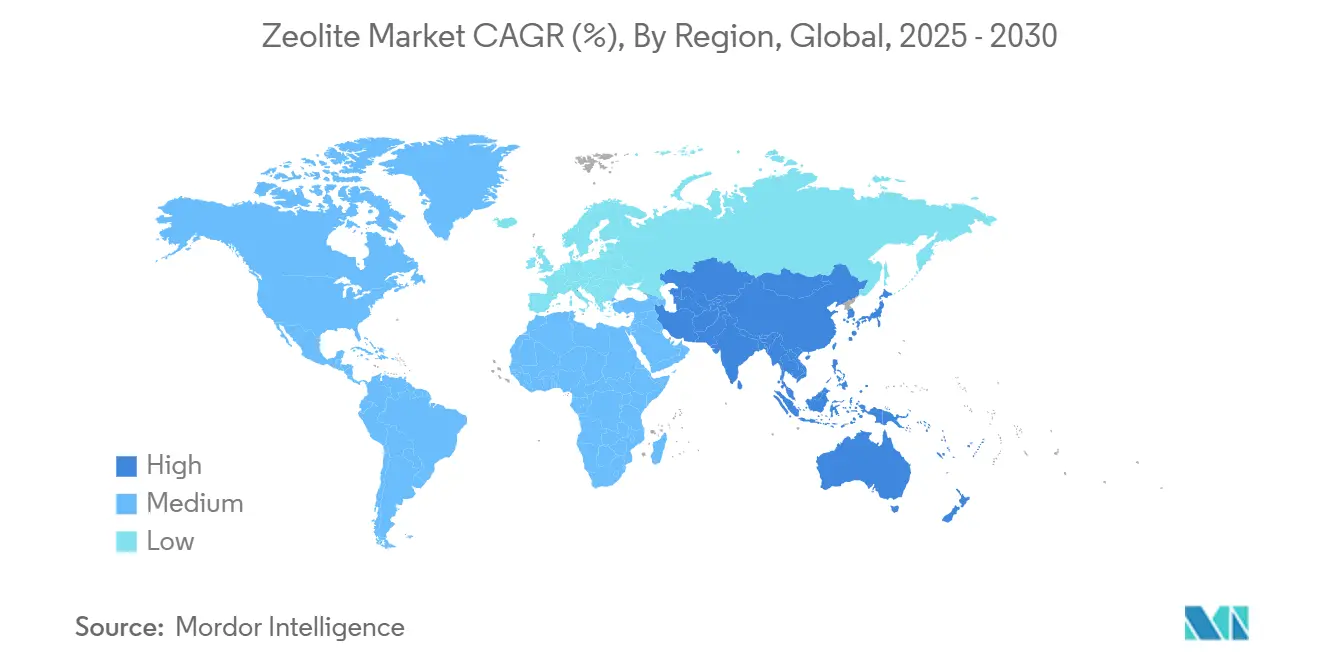
Competitive Landscape
The zeolite market is moderately fragmented. Strategic alliances align catalyst technology with circular-economy opportunities. Regional specialists in China and India expand capacity at double-digit rates, leveraging cost efficiencies to challenge incumbents in commodity powder grades. Some are pivoting toward membrane products and biomedical niches, evidenced by PMA-Zeolite’s gastrointestinal detox formulations.
Zeolites Industry Leaders
-
BASF
-
Clariant
-
Honeywell International Inc.
-
TOSOH CORPORATION
-
W. R. Grace & Co
- *Disclaimer: Major Players sorted in no particular order
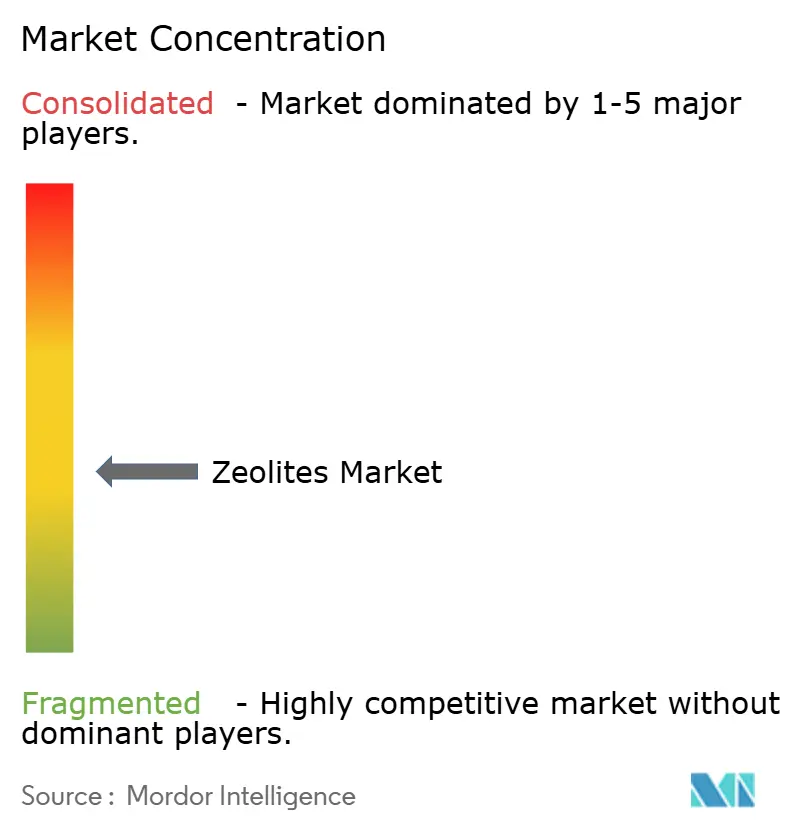
Recent Industry Developments
- January 2024: W.R. Grace & Co. earmarked USD 300 million to expand Louisiana sites, including USD 234 million for larger zeolite water-softening capacity.
- November 2023: Zeolyst International launched Opal Infinity zeolite products aimed at enhancing advanced plastic-recycling efficiency.
Research Methodology Framework and Report Scope
Market Definitions and Key Coverage
Our study treats the global zeolites market as the value generated from sales of naturally mined or industrially synthesized aluminosilicate frameworks that function as molecular sieves, ion exchangers, and solid-acid catalysts in bulk and specialty applications. According to Mordor Intelligence, sizing covers powder, pellet, block, and membrane forms sold into detergents, catalysts, adsorbents, water treatment, petrochemicals, construction, agriculture, and related end uses across 15 major countries.
Scope exclusion: Other crystalline aluminosilicates that are not classified by the International Zeolite Association are left outside the boundary.
Segmentation Overview
- By Product Type
- Natural Zeolite
- Synthetic Zeolite
- By Form
- Powder
- Granules / Pellets
- Honeycomb / Blocks
- Membranes / Coatings
- By Application
- Adsorbents
- Catalysts
- Detergents
- Other Application (Refining and Biogas)
- By End-user Industry
- Water Treatment
- Air Purification
- Agriculture
- Petrochemical
- Construction
- Others (Medical, Nuclear)
- By Geography
- Asia-Pacific
- China
- India
- Japan
- South Korea
- ASEAN
- Rest of Asia-Pacific
- North America
- United States
- Canada
- Mexico
- Europe
- Germany
- United Kingdom
- France
- Italy
- Nordics
- Rest of Europe
- South America
- Brazil
- Argentina
- Chile
- Rest of South America
- Middle-East and Africa
- Saudi Arabia
- United Arab Emirates
- South Africa
- Egypt
- Rest of Middle-East and Africa
- Asia-Pacific
Detailed Research Methodology and Data Validation
Primary Research
Structured interviews with producers, detergent formulators, refinery catalyst buyers, and water-utility engineers across Asia-Pacific, North America, and Europe enabled us to cross-check volume spreads, typical contract prices, substitute pressure, and forward capacity plans. Follow-up email surveys captured average selling-price corridors and emerging purity specifications, allowing Mordor analysts to resolve data gaps and refine scenario assumptions.
Desk Research
We began with public statistical portals, UN Comtrade shipment codes for aluminosilicate minerals, USGS Minerals Yearbook tonnage trends, and Eurostat PRODCOM output because they reveal trade flows and regional production clusters. Trade-association briefs from the International Zeolite Association and American Chemistry Council then helped us align framework nomenclature and purity grades with commercial classifications. Company 10-Ks, select patent families accessed via Questel, and press releases archived on Dow Jones Factiva rounded out price, capacity, and technology cues.
To benchmark demand pull, analysts screened regulatory documents, EU Detergent Regulation and China's phosphate-free mandates, alongside World Bank wastewater investment dashboards, thereby tying policy triggers to consumption. The sources listed are illustrative; dozens of other public and proprietary references informed data gathering, validation, and clarification.
Market-Sizing & Forecasting
A calibrated top-down model starts with regional production plus net trade to reconstruct apparent consumption, followed by application-specific penetration factors (e.g., zeolite kg per ton of powdered detergent, catalysts per barrel of oil refined). Bottom-up supplier roll-ups and sampled ASP × volume checks act as guardrails, and gaps in lightly reported niches are bridged through triangulated averages from interview price bands. Key variables like crude-throughput trends, detergent powder output, industrial water reuse spending, standard ASP drift, and natural-to-synthetic substitution rates feed a multivariate-regression engine that projects demand to 2030. Where statistical series are missing, we interpolate using three-year moving averages validated in expert calls.
Data Validation & Update Cycle
Before release, outputs pass anomaly screens, variance checks against external indices, and a two-step peer review. We refresh every twelve months or sooner if raw-material shocks, major capacity additions, or regulatory shifts move the baseline. An analyst re-runs the model just prior to client delivery so you receive the most current view.
Why Mordor's Zeolites Baseline Commands Confidence
Published figures often diverge because firms differ on what counts as zeolite, which applications they tally, and how quickly they refresh models.
Key gap drivers include: some publishers roll detergent-builder ASPs into broader surfactant pools, others apply aggressive refinery throughput growth or rely on unpublished supplier interviews without public trade validation, and many lock models for three-year intervals whereas Mordor updates annually. Currency conversion years and inflation treatments further widen spreads.
Benchmark comparison
| Market Size | Anonymized source | Primary gap driver |
|---|---|---|
| USD 9.56 B, 2025 | Mordor Intelligence | - |
| USD 14.74 B, 2024 | Global Consultancy A | Includes zeolite-like aluminosilicates and lumps specialty catalysts, limited trade cross-checks |
| USD 8.96 B, 2024 | Market Data Firm B | Excludes construction-grade natural zeolites and uses static ASPs fixed in 2022 |
The comparison shows that while other estimates swing wide, Mordor's disciplined scope, mixed-method modeling, and yearly refresh deliver a balanced, transparent baseline that decision-makers can trace back to clear variables and repeatable steps.
Key Questions Answered in the Report
How large is the zeolite market today, and how fast will it grow?
The zeolite market stands at USD 9.56 billion in 2025 and is projected to reach USD 11.6 billion by 2030, advancing at a 3.94% CAGR.
Which region represents the biggest opportunity for zeolite suppliers?
Asia-Pacific leads with 45% of global revenue in 2024 and is forecast to grow at 6.20% CAGR, buoyed by petrochemical expansion and stricter environmental rules.
What application segment is expanding the fastest?
Water treatment is the most dynamic end-use, growing at 6.50% CAGR as utilities adopt high-capacity zeolite adsorbents for heavy-metal and trace-organic removal.
Why are synthetic zeolites gaining share despite higher cost?
Engineered pore structures and controllable acidity give synthetic zeolites superior catalytic performance, driving a 5.60% CAGR in segments such as FCC and NOx reduction.
How is feedstock volatility affecting zeolite producers?
Restrictions on bauxite mining raise alumina prices, squeezing synthetic zeolite margins; green synthesis using kaolin waste is emerging as a mitigation route.
Page last updated on:
